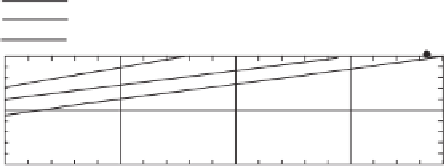Environmental Engineering Reference
In-Depth Information
of the constitutive surface cross section at a constant void ratio
when plotted using the arithmetic and logarithmic scales. An
essentially linear cross section on the arithmetic plot becomes
an asymptotic curve on the logarithmic plot.
The asymptotic cross-sectional curve illustrates the
logarithmic form of the void ratio constitutive surface in
Fig. 13.28a. Ho (1988) proposed an approximate form of
the void ratio constitutive surface, as shown in Fig. 13.28b.
The approximate surface consists of three planes, namely,
planes I, II, and III. The three planes converge at a void ratio
ordinate corresponding to nominal values of the stress state
variables [i.e.,
log
σ
−
u
a
≈
0 and log
u
a
−
u
w
≈
0].
Planes I and III are referred to as the orthogonal planes.
Plane I is perpendicular to the
e
-log
σ
−
u
a
plane and
has a slope in which is represented by the
C
t
index. Plane
III is perpendicular to the
e
-log
u
a
−
u
w
plane and has
a slope represented by the
C
m
index. In other words,
only one index is required to describe void ratio changes
when the stress state variable changes occur within the
Figure 13.26
Typical SWCC plotted to semilogarithmic scale.
Remolded Madrid clay
Legend
γ
0
(kN/m
3
)
w
0
(%)
P
s
-max
(kPa)
w
f
(%)
S
f
(%)
4.7
11.0
16.6
15.4
15.4
15.6
484
388
244
27.1
26.3
27.8
101.0
98.6
106.0
0
500
1000
0
1000
2000
3000
Matric suction, (
u
a
-
u
w
) (kPa)
(a)
1
10
100
1000
1
10
100
1000
10,000
Matric suction, (
u
a
-
u
w
) (kPa)
(b)
Figure 13.27
Cross section of void ratio surface plotted using arithmetic and logarithmic scales:
(a) cross section showing stress state changes across constant-void-ratio surfaces on arithmetic
scale; (b) cross section showing stress state changes across constant-void-ratio surfaces on loga-
rithmic scale (modified after Escario, 1969).












































Search WWH ::

Custom Search